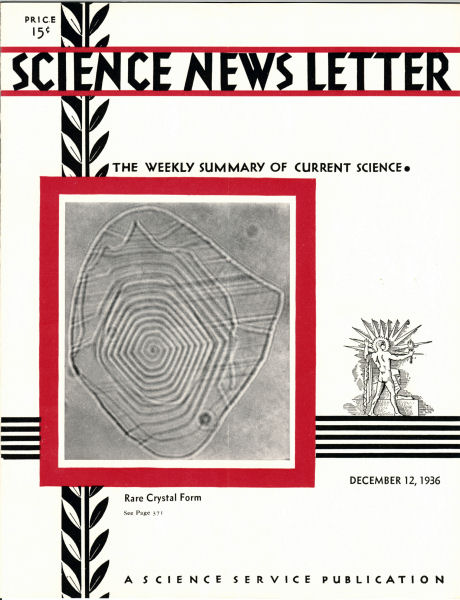From the December 12, 1936, issue

SPIRAL ORGANIZATION FOUND IN PARAFFIN CRYSTALS
Spiral organization, so common in plant and animal life and almost universal in nebulae, is a very rare phenomenon in inanimate molecular structures. Preserved in Princeton’s museum is a carborundum crystal that has on it a spot the size of a pinhead, which when magnified shows a simple but perfect spiral. Also, in rare cases, the face of a quartz crystal properly etched will show a type of spiral.
Spirals in abundance and of rare beauty have recently been discovered by Prof. C.M. Heck of North Carolina State College, and that, too, in common paraffin. Shown on the cover of this week’s Science News Letter is one of these spiral crystals as it grew from a solution of paraffin in mineral oil. It is magnified 1,200 diameters and shows each convolution repeating with exactness the exterior outlines of the crystal, a significant element of the discovery.
Professor Heck discovered these crystals while researching on the equilibrium conditions shown between solid and liquid compounds of the paraffin chemical series. His findings are proving of much interest to the refiners of oils and gasolines as they show paraffin crystals to be sensitive detectors of foreign materials when in these products. The crystals vary their shape and internal structure markedly. For example, these spirals are found to double and become twin spirals in certain cases, one spiral turning clockwise and the other counter-clockwise in most cases.
No explanation of the spiral formation is given by Professor Heck, though he finds strong indications that all tabular paraffin crystals have a spiral structure that becomes visible only in exaggerated cases. Analysis with polarized light so far has not shown any difference between crystals with visible spirals and those without them.
LIFESAVER FOR “BLEEDERS” FOUND—IN EGG WHITE
The curse of the Hapsburgs has been foiled—by egg white.
The threat of death is now lifted from the heads of royalty and commoners alike who suffer under this curse, the dangerous, hereditary disease of hemophilia. These men and boys (the disease is transmitted by women but afflicts only males) need no longer lead a timid, hothouse existence for fear a scratch or slight exertion will bring on fatal bleeding.
The remedy, which could have saved the lives of kings and princes of the past, has been discovered by three University of Sheffield medical scientists, Drs. W.A. Timperley, A.E. Naish, and G.A. Clark.
SEEDLESS FRUITS FORMED IN UNPOLLINATED FLOWERS
Seedless tomatoes and peppers have been induced to form in unpollinated flowers by treating the fruit-producing parts, or ovaries, with any one of four different organic acids, Dr. Felix G. Gustafson of the University of Michigan has reported to the National Academy of Sciences through that body’s official Proceedings. (November.) Similar results were also obtained with the fruits and seedpods of other vegetables and garden flowers.
While no immediate commercial application is contemplated, it is interesting to note that in the tomatoes, at least, the seedless specimens had very small locules or seed-spaces—indeed, in some of the smaller ones, the flesh was completely solid. Immediate commercial exploitation is regarded as impracticable at present because each flower requires individual operation by a skilled botanist. The real significance of the experiments is proof that fruit production without pollination is possible by use of growth-promoting substances.